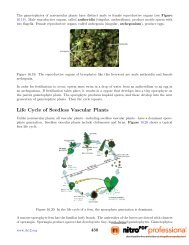Chapter 23 The Circulatory, Respiratory, Digestive, and Excretory ...
Chapter 23 The Circulatory, Respiratory, Digestive, and Excretory ...
Chapter 23 The Circulatory, Respiratory, Digestive, and Excretory ...
You also want an ePaper? Increase the reach of your titles
YUMPU automatically turns print PDFs into web optimized ePapers that Google loves.
• Arteries are muscular blood vessels that carry blood away from the heart. <strong>The</strong>y have thick walls that<br />
can withst<strong>and</strong> the pressure of blood being pumped by the heart. Arteries generally carry oxygen-rich<br />
blood. <strong>The</strong> largest artery is the aorta, which receives blood directly from the heart.<br />
• Veins are blood vessels that carry blood toward the heart. This blood is no longer under much pressure,<br />
so many veins have valves that prevent backflow of blood. Veins generally carry deoxygenated<br />
blood. <strong>The</strong> largest vein is the inferior vena cava, which carries blood from the lower body to the<br />
heart.<br />
• Capillaries are the smallest type of blood vessels. <strong>The</strong>y connect very small arteries <strong>and</strong> veins. <strong>The</strong><br />
exchange of gases <strong>and</strong> other substances between cells <strong>and</strong> the blood takes place across the extremely<br />
thin walls of capillaries.<br />
Blood Vessels <strong>and</strong> Homeostasis<br />
Blood vessels help regulate body processes by either constricting (becoming narrower) or dilating (becoming<br />
wider). <strong>The</strong>se actions occur in response to signals from the autonomic nervous system or the endocrine<br />
system. Constriction occurs when the muscular walls of blood vessels contract. This reduces the amount<br />
of blood that can flow through the vessels (see Figure <strong>23</strong>.4). Dilation occurs when the walls relax. This<br />
increases blood flows through the vessels.<br />
Figure <strong>23</strong>.4: When a blood vessel constricts, less blood can flow through it.<br />
Constriction <strong>and</strong> dilation allow the circulatory system to change the amount of blood flowing to different<br />
organs. For example, during a fight-or-flight response, dilation <strong>and</strong> constriction of blood vessels allow more<br />
blood to flow to skeletal muscles <strong>and</strong> less to flow to digestive organs. Dilation of blood vessels in the skin<br />
allows more blood to flow to the body surface so the body can lose heat. Constriction of these blood vessels<br />
has the opposite effect <strong>and</strong> helps conserve body heat.<br />
691 www.ck12.org





